Financial Statement Analysis: Accounting for Managers Assignment
VerifiedAdded on 2022/10/02
|9
|1079
|39
Homework Assignment
AI Summary
This assignment solution provides a comprehensive analysis of financial statements for an Accounting for Managers course. The document includes the preparation of an income statement and balance sheet for Kennett Building Services, detailing revenue, expenses, assets, liabilities, and equity. It also presents a second question, which includes an income statement, a balance sheet, a cash flow statement, and an analysis of how a client withdrawal would impact the financial statements. The assignment covers key accounting concepts such as gross profit, net profit, current and non-current assets and liabilities, and equity. The solution demonstrates the application of accounting principles to real-world business scenarios and provides insights into financial performance and position, offering a practical guide for students studying accounting.
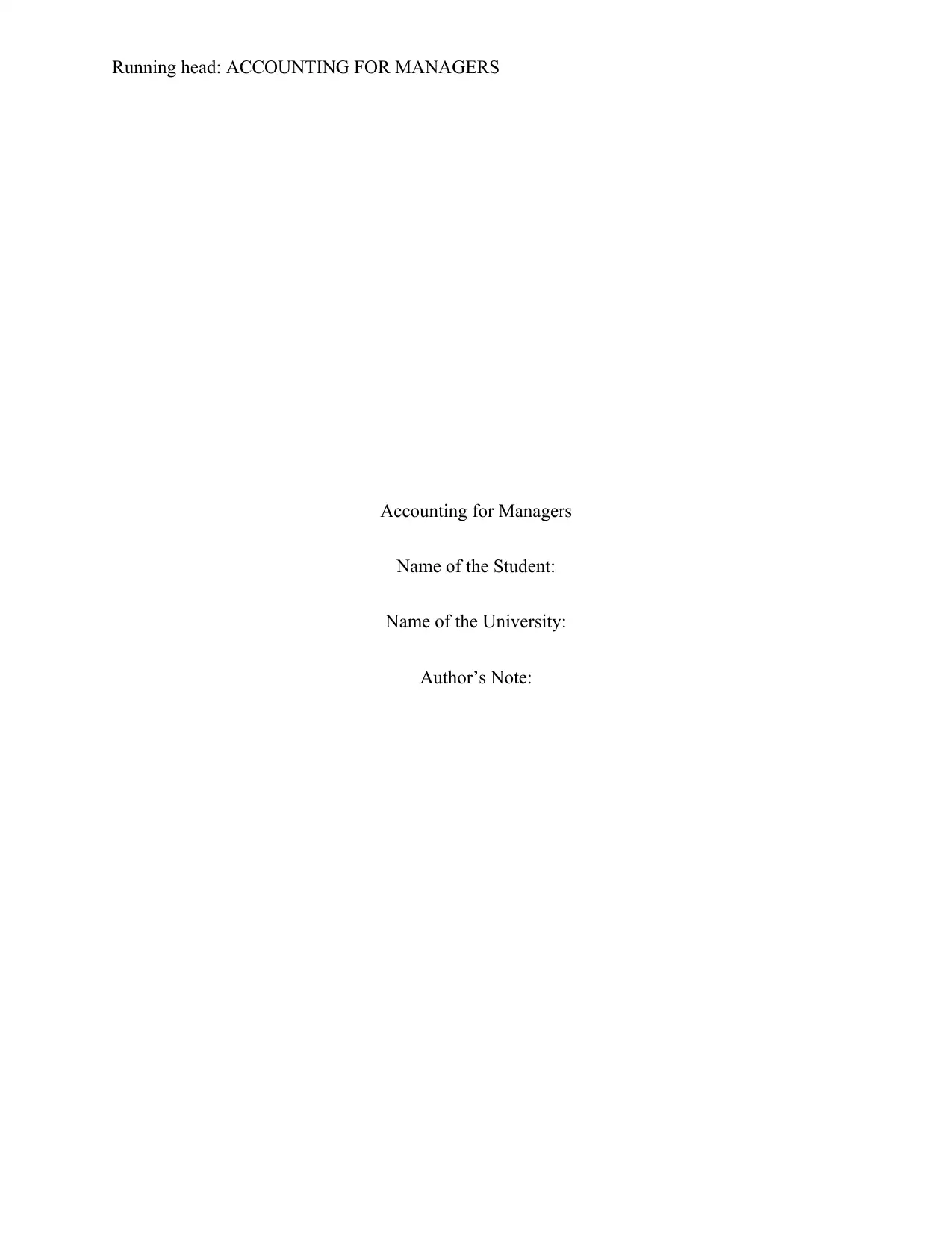
Running head: ACCOUNTING FOR MANAGERS
Accounting for Managers
Name of the Student:
Name of the University:
Author’s Note:
Accounting for Managers
Name of the Student:
Name of the University:
Author’s Note:
Paraphrase This Document
Need a fresh take? Get an instant paraphrase of this document with our AI Paraphraser
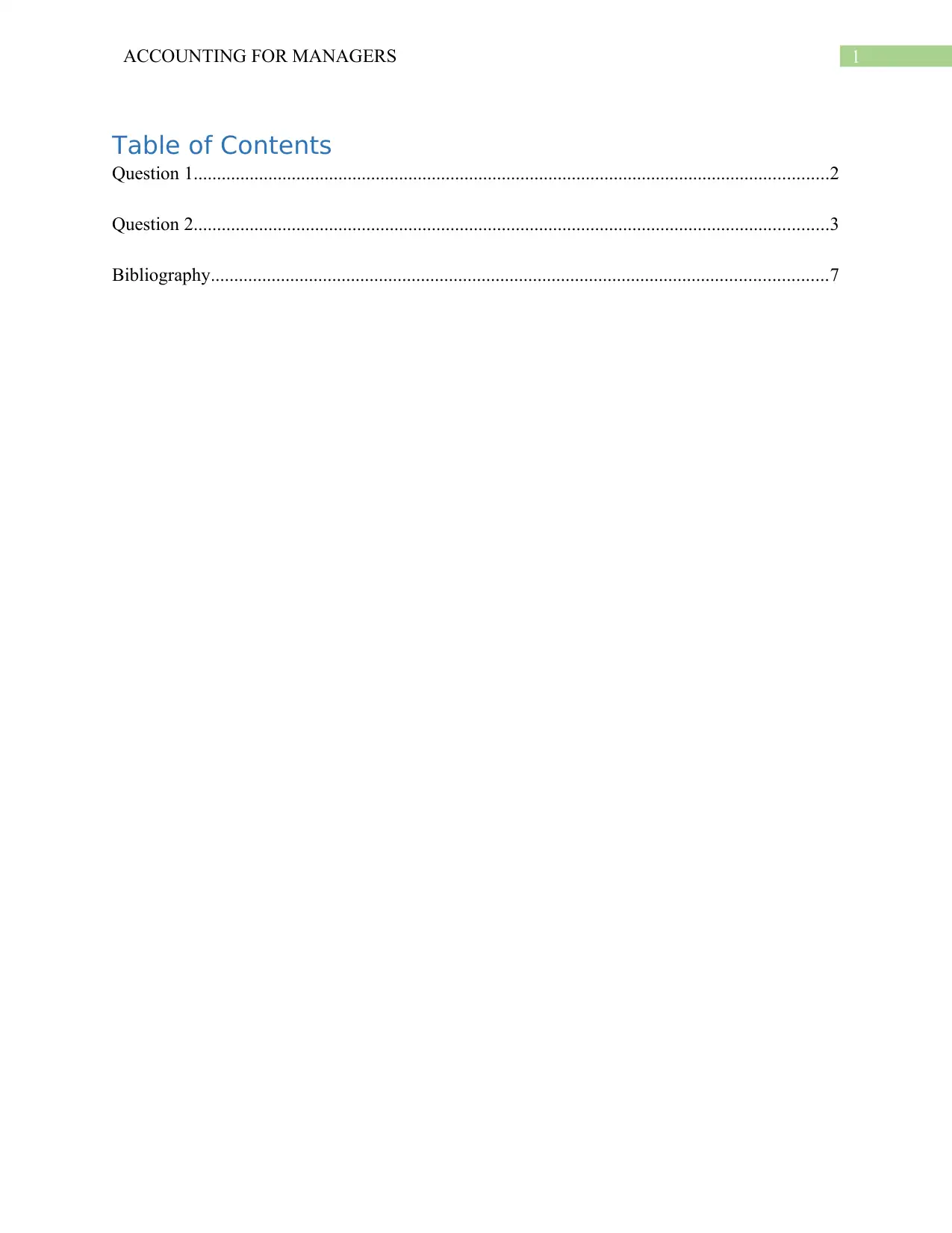
1ACCOUNTING FOR MANAGERS
Table of Contents
Question 1........................................................................................................................................2
Question 2........................................................................................................................................3
Bibliography....................................................................................................................................7
Table of Contents
Question 1........................................................................................................................................2
Question 2........................................................................................................................................3
Bibliography....................................................................................................................................7
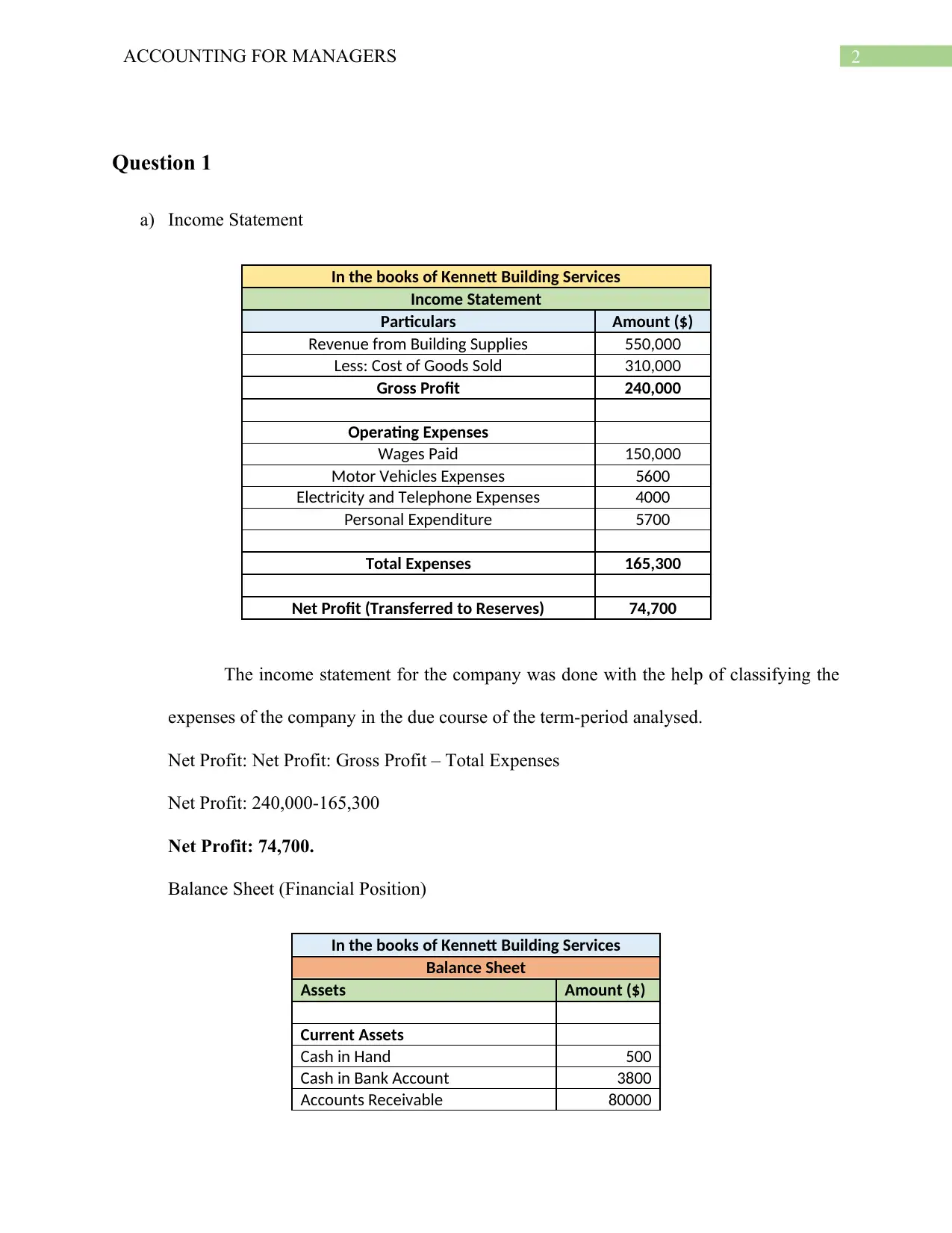
2ACCOUNTING FOR MANAGERS
Question 1
a) Income Statement
In the books of Kennett Building Services
Income Statement
Particulars Amount ($)
Revenue from Building Supplies 550,000
Less: Cost of Goods Sold 310,000
Gross Profit 240,000
Operating Expenses
Wages Paid 150,000
Motor Vehicles Expenses 5600
Electricity and Telephone Expenses 4000
Personal Expenditure 5700
Total Expenses 165,300
Net Profit (Transferred to Reserves) 74,700
The income statement for the company was done with the help of classifying the
expenses of the company in the due course of the term-period analysed.
Net Profit: Net Profit: Gross Profit – Total Expenses
Net Profit: 240,000-165,300
Net Profit: 74,700.
Balance Sheet (Financial Position)
In the books of Kennett Building Services
Balance Sheet
Assets Amount ($)
Current Assets
Cash in Hand 500
Cash in Bank Account 3800
Accounts Receivable 80000
Question 1
a) Income Statement
In the books of Kennett Building Services
Income Statement
Particulars Amount ($)
Revenue from Building Supplies 550,000
Less: Cost of Goods Sold 310,000
Gross Profit 240,000
Operating Expenses
Wages Paid 150,000
Motor Vehicles Expenses 5600
Electricity and Telephone Expenses 4000
Personal Expenditure 5700
Total Expenses 165,300
Net Profit (Transferred to Reserves) 74,700
The income statement for the company was done with the help of classifying the
expenses of the company in the due course of the term-period analysed.
Net Profit: Net Profit: Gross Profit – Total Expenses
Net Profit: 240,000-165,300
Net Profit: 74,700.
Balance Sheet (Financial Position)
In the books of Kennett Building Services
Balance Sheet
Assets Amount ($)
Current Assets
Cash in Hand 500
Cash in Bank Account 3800
Accounts Receivable 80000
⊘ This is a preview!⊘
Do you want full access?
Subscribe today to unlock all pages.

Trusted by 1+ million students worldwide
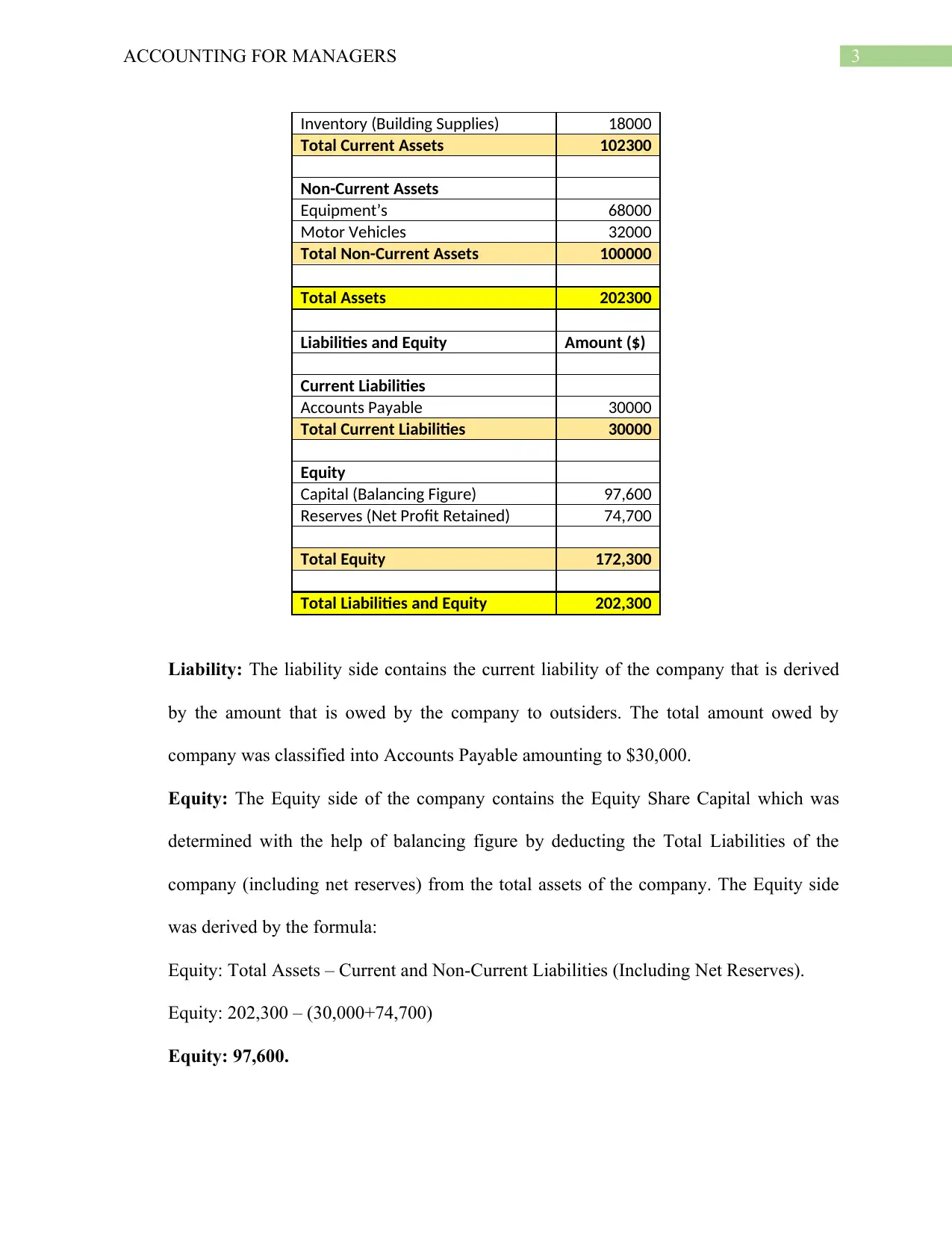
3ACCOUNTING FOR MANAGERS
Inventory (Building Supplies) 18000
Total Current Assets 102300
Non-Current Assets
Equipment’s 68000
Motor Vehicles 32000
Total Non-Current Assets 100000
Total Assets 202300
Liabilities and Equity Amount ($)
Current Liabilities
Accounts Payable 30000
Total Current Liabilities 30000
Equity
Capital (Balancing Figure) 97,600
Reserves (Net Profit Retained) 74,700
Total Equity 172,300
Total Liabilities and Equity 202,300
Liability: The liability side contains the current liability of the company that is derived
by the amount that is owed by the company to outsiders. The total amount owed by
company was classified into Accounts Payable amounting to $30,000.
Equity: The Equity side of the company contains the Equity Share Capital which was
determined with the help of balancing figure by deducting the Total Liabilities of the
company (including net reserves) from the total assets of the company. The Equity side
was derived by the formula:
Equity: Total Assets – Current and Non-Current Liabilities (Including Net Reserves).
Equity: 202,300 – (30,000+74,700)
Equity: 97,600.
Inventory (Building Supplies) 18000
Total Current Assets 102300
Non-Current Assets
Equipment’s 68000
Motor Vehicles 32000
Total Non-Current Assets 100000
Total Assets 202300
Liabilities and Equity Amount ($)
Current Liabilities
Accounts Payable 30000
Total Current Liabilities 30000
Equity
Capital (Balancing Figure) 97,600
Reserves (Net Profit Retained) 74,700
Total Equity 172,300
Total Liabilities and Equity 202,300
Liability: The liability side contains the current liability of the company that is derived
by the amount that is owed by the company to outsiders. The total amount owed by
company was classified into Accounts Payable amounting to $30,000.
Equity: The Equity side of the company contains the Equity Share Capital which was
determined with the help of balancing figure by deducting the Total Liabilities of the
company (including net reserves) from the total assets of the company. The Equity side
was derived by the formula:
Equity: Total Assets – Current and Non-Current Liabilities (Including Net Reserves).
Equity: 202,300 – (30,000+74,700)
Equity: 97,600.
Paraphrase This Document
Need a fresh take? Get an instant paraphrase of this document with our AI Paraphraser
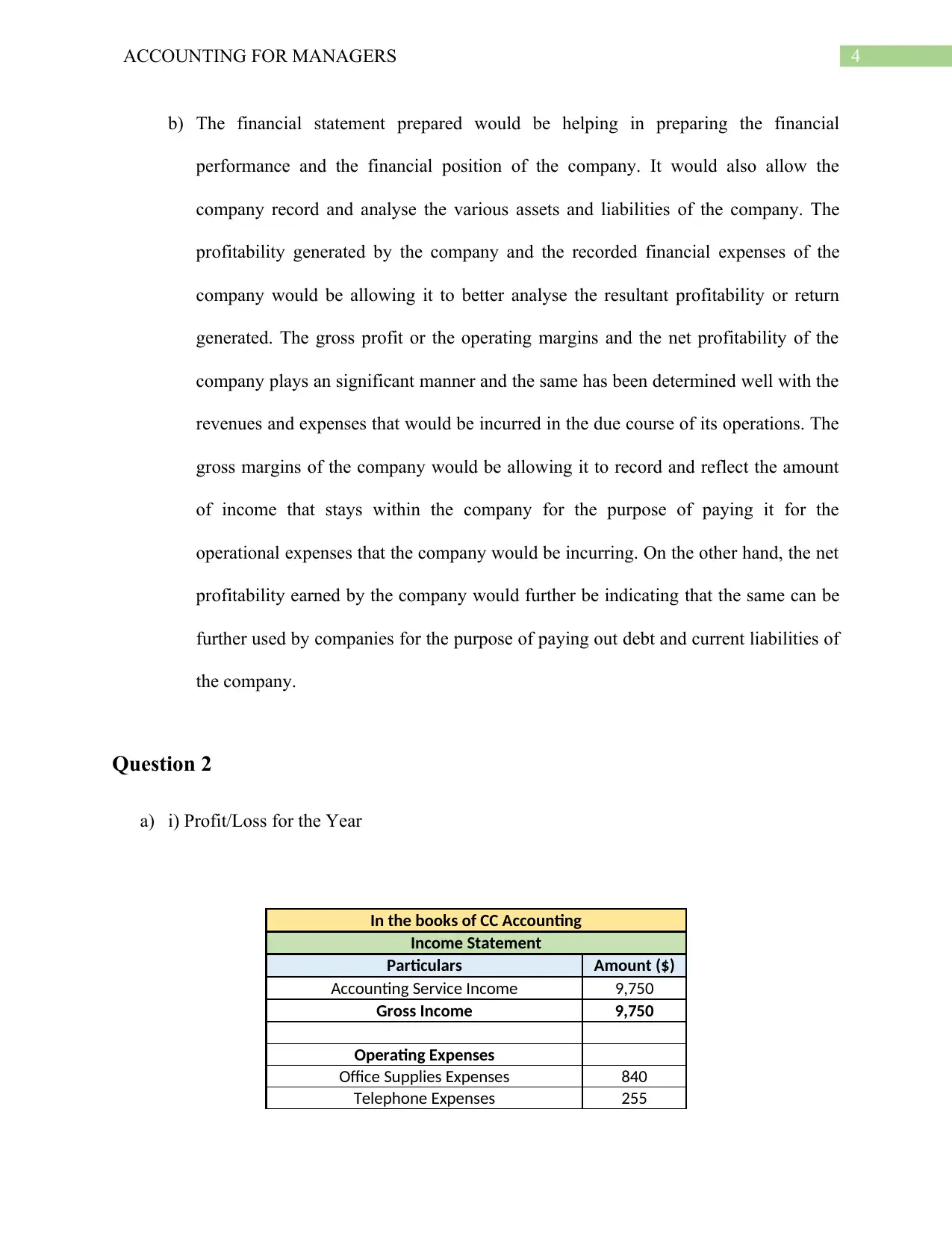
4ACCOUNTING FOR MANAGERS
b) The financial statement prepared would be helping in preparing the financial
performance and the financial position of the company. It would also allow the
company record and analyse the various assets and liabilities of the company. The
profitability generated by the company and the recorded financial expenses of the
company would be allowing it to better analyse the resultant profitability or return
generated. The gross profit or the operating margins and the net profitability of the
company plays an significant manner and the same has been determined well with the
revenues and expenses that would be incurred in the due course of its operations. The
gross margins of the company would be allowing it to record and reflect the amount
of income that stays within the company for the purpose of paying it for the
operational expenses that the company would be incurring. On the other hand, the net
profitability earned by the company would further be indicating that the same can be
further used by companies for the purpose of paying out debt and current liabilities of
the company.
Question 2
a) i) Profit/Loss for the Year
In the books of CC Accounting
Income Statement
Particulars Amount ($)
Accounting Service Income 9,750
Gross Income 9,750
Operating Expenses
Office Supplies Expenses 840
Telephone Expenses 255
b) The financial statement prepared would be helping in preparing the financial
performance and the financial position of the company. It would also allow the
company record and analyse the various assets and liabilities of the company. The
profitability generated by the company and the recorded financial expenses of the
company would be allowing it to better analyse the resultant profitability or return
generated. The gross profit or the operating margins and the net profitability of the
company plays an significant manner and the same has been determined well with the
revenues and expenses that would be incurred in the due course of its operations. The
gross margins of the company would be allowing it to record and reflect the amount
of income that stays within the company for the purpose of paying it for the
operational expenses that the company would be incurring. On the other hand, the net
profitability earned by the company would further be indicating that the same can be
further used by companies for the purpose of paying out debt and current liabilities of
the company.
Question 2
a) i) Profit/Loss for the Year
In the books of CC Accounting
Income Statement
Particulars Amount ($)
Accounting Service Income 9,750
Gross Income 9,750
Operating Expenses
Office Supplies Expenses 840
Telephone Expenses 255
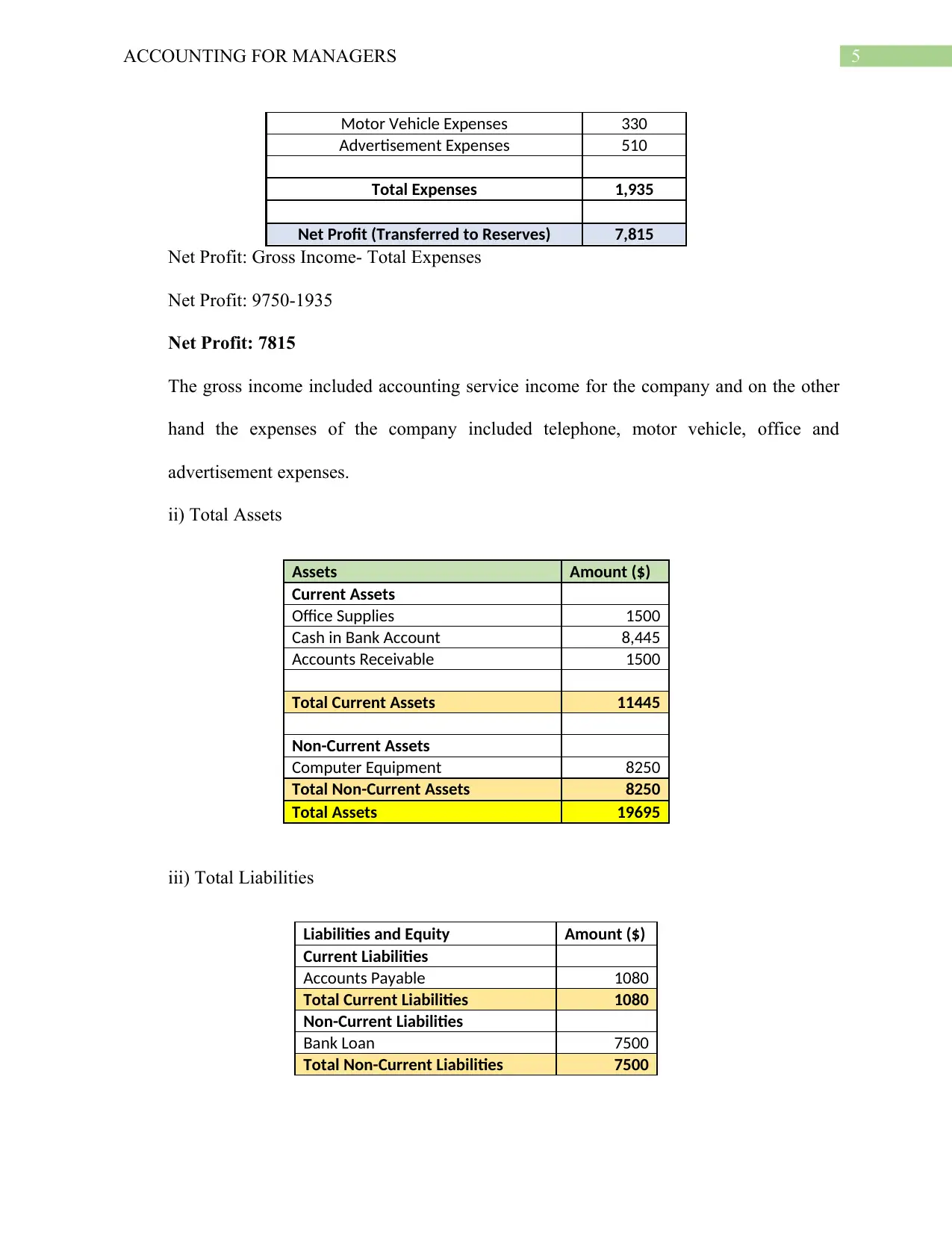
5ACCOUNTING FOR MANAGERS
Motor Vehicle Expenses 330
Advertisement Expenses 510
Total Expenses 1,935
Net Profit (Transferred to Reserves) 7,815
Net Profit: Gross Income- Total Expenses
Net Profit: 9750-1935
Net Profit: 7815
The gross income included accounting service income for the company and on the other
hand the expenses of the company included telephone, motor vehicle, office and
advertisement expenses.
ii) Total Assets
Assets Amount ($)
Current Assets
Office Supplies 1500
Cash in Bank Account 8,445
Accounts Receivable 1500
Total Current Assets 11445
Non-Current Assets
Computer Equipment 8250
Total Non-Current Assets 8250
Total Assets 19695
iii) Total Liabilities
Liabilities and Equity Amount ($)
Current Liabilities
Accounts Payable 1080
Total Current Liabilities 1080
Non-Current Liabilities
Bank Loan 7500
Total Non-Current Liabilities 7500
Motor Vehicle Expenses 330
Advertisement Expenses 510
Total Expenses 1,935
Net Profit (Transferred to Reserves) 7,815
Net Profit: Gross Income- Total Expenses
Net Profit: 9750-1935
Net Profit: 7815
The gross income included accounting service income for the company and on the other
hand the expenses of the company included telephone, motor vehicle, office and
advertisement expenses.
ii) Total Assets
Assets Amount ($)
Current Assets
Office Supplies 1500
Cash in Bank Account 8,445
Accounts Receivable 1500
Total Current Assets 11445
Non-Current Assets
Computer Equipment 8250
Total Non-Current Assets 8250
Total Assets 19695
iii) Total Liabilities
Liabilities and Equity Amount ($)
Current Liabilities
Accounts Payable 1080
Total Current Liabilities 1080
Non-Current Liabilities
Bank Loan 7500
Total Non-Current Liabilities 7500
⊘ This is a preview!⊘
Do you want full access?
Subscribe today to unlock all pages.

Trusted by 1+ million students worldwide
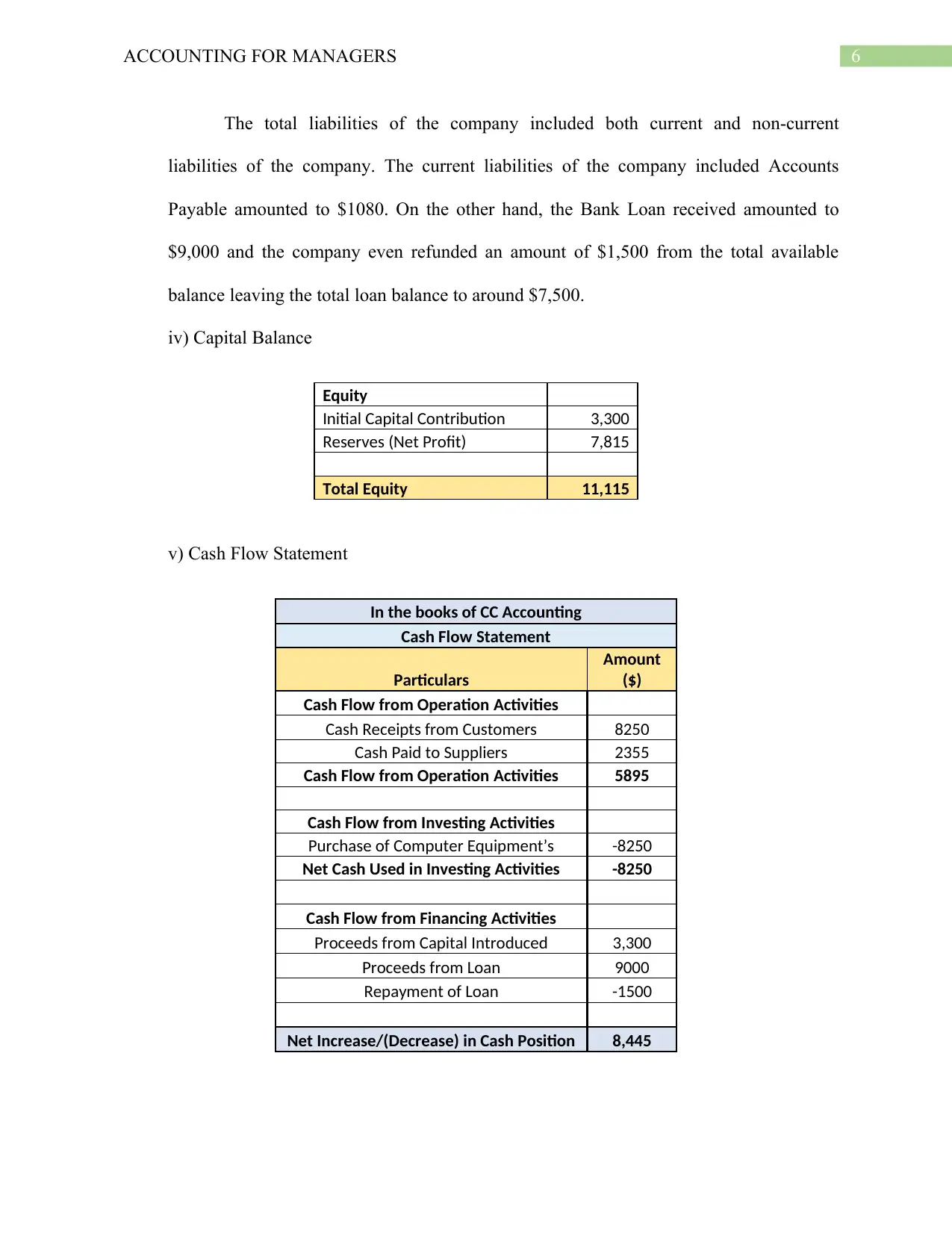
6ACCOUNTING FOR MANAGERS
The total liabilities of the company included both current and non-current
liabilities of the company. The current liabilities of the company included Accounts
Payable amounted to $1080. On the other hand, the Bank Loan received amounted to
$9,000 and the company even refunded an amount of $1,500 from the total available
balance leaving the total loan balance to around $7,500.
iv) Capital Balance
Equity
Initial Capital Contribution 3,300
Reserves (Net Profit) 7,815
Total Equity 11,115
v) Cash Flow Statement
In the books of CC Accounting
Cash Flow Statement
Particulars
Amount
($)
Cash Flow from Operation Activities
Cash Receipts from Customers 8250
Cash Paid to Suppliers 2355
Cash Flow from Operation Activities 5895
Cash Flow from Investing Activities
Purchase of Computer Equipment’s -8250
Net Cash Used in Investing Activities -8250
Cash Flow from Financing Activities
Proceeds from Capital Introduced 3,300
Proceeds from Loan 9000
Repayment of Loan -1500
Net Increase/(Decrease) in Cash Position 8,445
The total liabilities of the company included both current and non-current
liabilities of the company. The current liabilities of the company included Accounts
Payable amounted to $1080. On the other hand, the Bank Loan received amounted to
$9,000 and the company even refunded an amount of $1,500 from the total available
balance leaving the total loan balance to around $7,500.
iv) Capital Balance
Equity
Initial Capital Contribution 3,300
Reserves (Net Profit) 7,815
Total Equity 11,115
v) Cash Flow Statement
In the books of CC Accounting
Cash Flow Statement
Particulars
Amount
($)
Cash Flow from Operation Activities
Cash Receipts from Customers 8250
Cash Paid to Suppliers 2355
Cash Flow from Operation Activities 5895
Cash Flow from Investing Activities
Purchase of Computer Equipment’s -8250
Net Cash Used in Investing Activities -8250
Cash Flow from Financing Activities
Proceeds from Capital Introduced 3,300
Proceeds from Loan 9000
Repayment of Loan -1500
Net Increase/(Decrease) in Cash Position 8,445
Paraphrase This Document
Need a fresh take? Get an instant paraphrase of this document with our AI Paraphraser
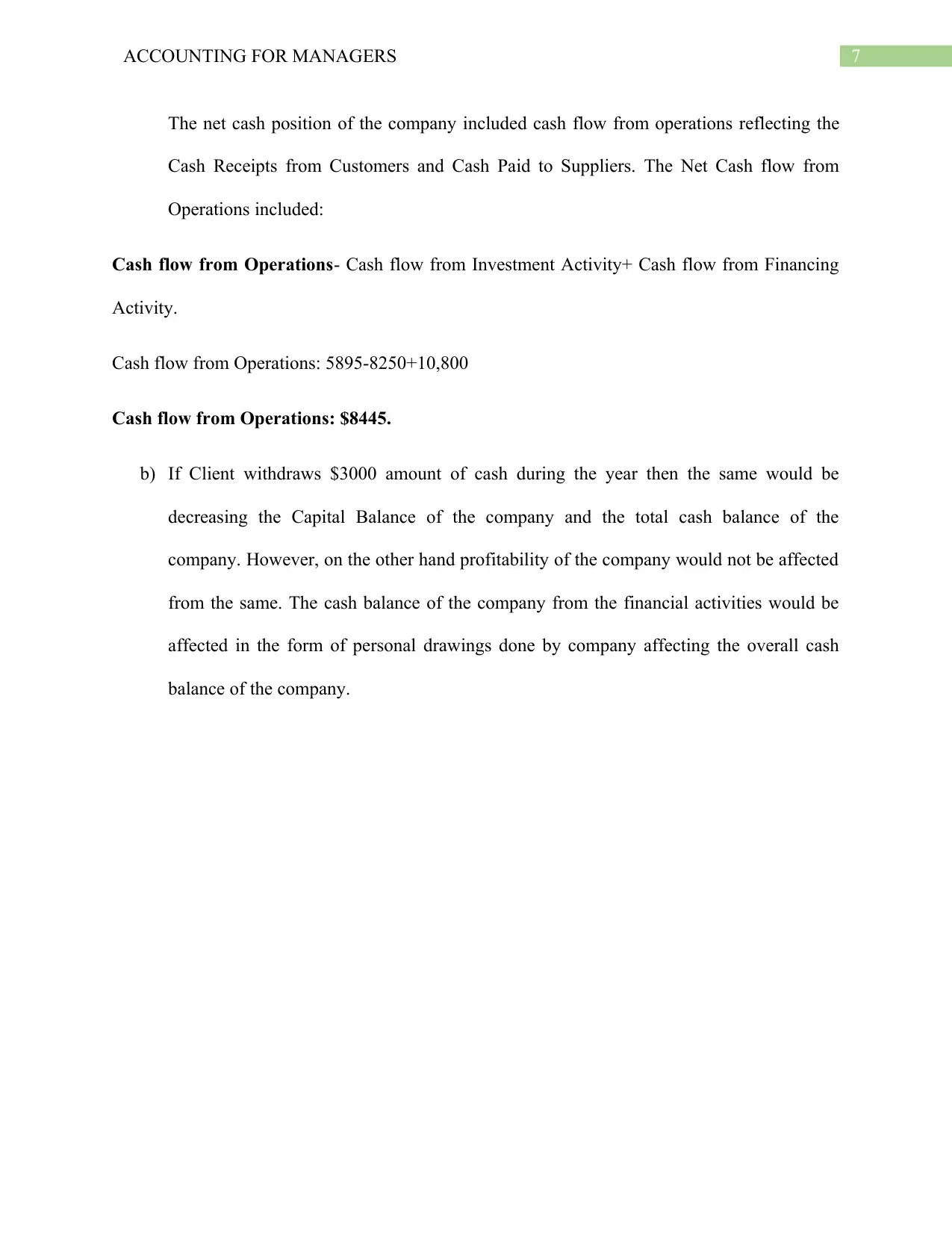
7ACCOUNTING FOR MANAGERS
The net cash position of the company included cash flow from operations reflecting the
Cash Receipts from Customers and Cash Paid to Suppliers. The Net Cash flow from
Operations included:
Cash flow from Operations- Cash flow from Investment Activity+ Cash flow from Financing
Activity.
Cash flow from Operations: 5895-8250+10,800
Cash flow from Operations: $8445.
b) If Client withdraws $3000 amount of cash during the year then the same would be
decreasing the Capital Balance of the company and the total cash balance of the
company. However, on the other hand profitability of the company would not be affected
from the same. The cash balance of the company from the financial activities would be
affected in the form of personal drawings done by company affecting the overall cash
balance of the company.
The net cash position of the company included cash flow from operations reflecting the
Cash Receipts from Customers and Cash Paid to Suppliers. The Net Cash flow from
Operations included:
Cash flow from Operations- Cash flow from Investment Activity+ Cash flow from Financing
Activity.
Cash flow from Operations: 5895-8250+10,800
Cash flow from Operations: $8445.
b) If Client withdraws $3000 amount of cash during the year then the same would be
decreasing the Capital Balance of the company and the total cash balance of the
company. However, on the other hand profitability of the company would not be affected
from the same. The cash balance of the company from the financial activities would be
affected in the form of personal drawings done by company affecting the overall cash
balance of the company.
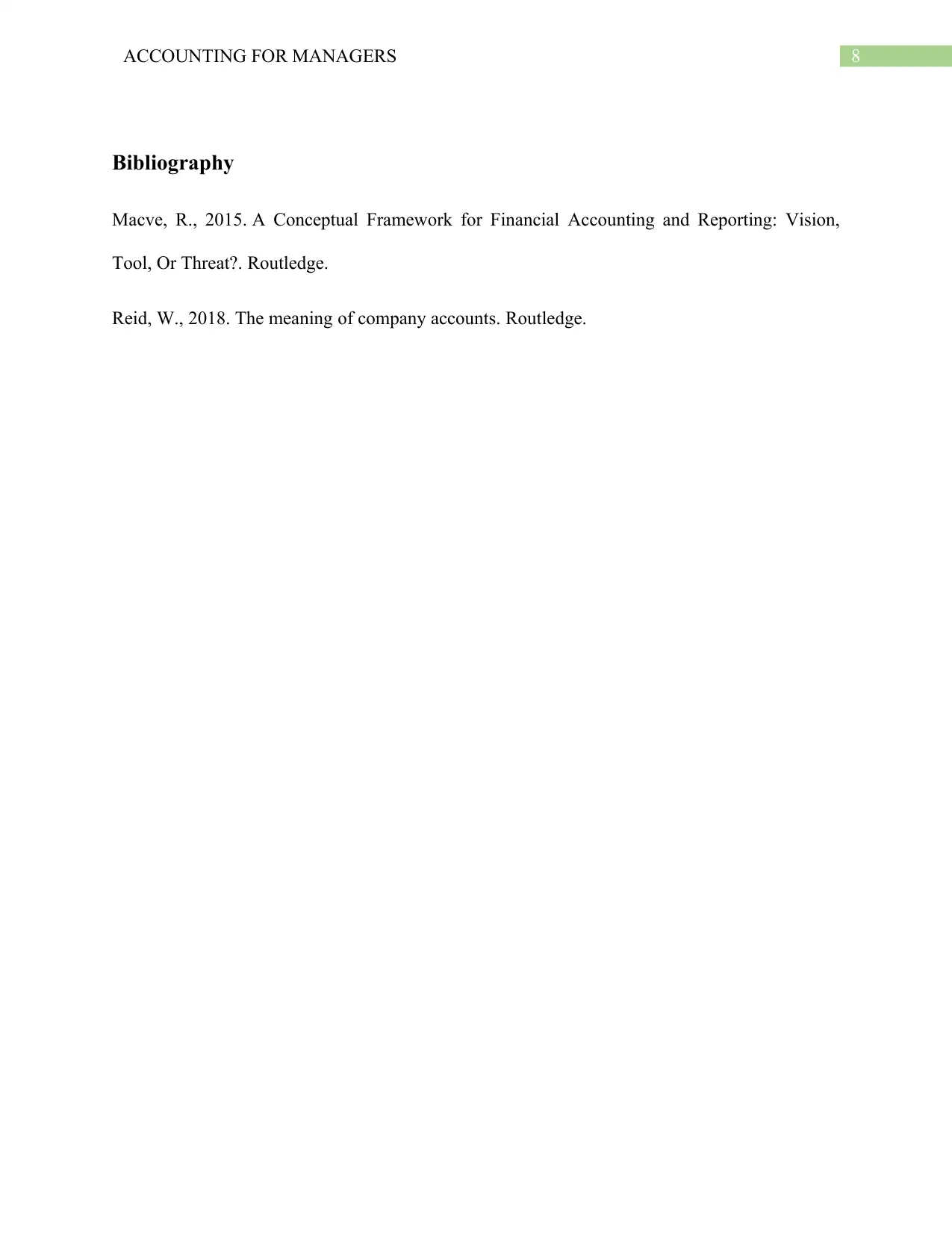
8ACCOUNTING FOR MANAGERS
Bibliography
Macve, R., 2015. A Conceptual Framework for Financial Accounting and Reporting: Vision,
Tool, Or Threat?. Routledge.
Reid, W., 2018. The meaning of company accounts. Routledge.
Bibliography
Macve, R., 2015. A Conceptual Framework for Financial Accounting and Reporting: Vision,
Tool, Or Threat?. Routledge.
Reid, W., 2018. The meaning of company accounts. Routledge.
⊘ This is a preview!⊘
Do you want full access?
Subscribe today to unlock all pages.

Trusted by 1+ million students worldwide
1 out of 9
Related Documents
Your All-in-One AI-Powered Toolkit for Academic Success.
+13062052269
info@desklib.com
Available 24*7 on WhatsApp / Email
![[object Object]](/_next/static/media/star-bottom.7253800d.svg)
Unlock your academic potential
Copyright © 2020–2025 A2Z Services. All Rights Reserved. Developed and managed by ZUCOL.




